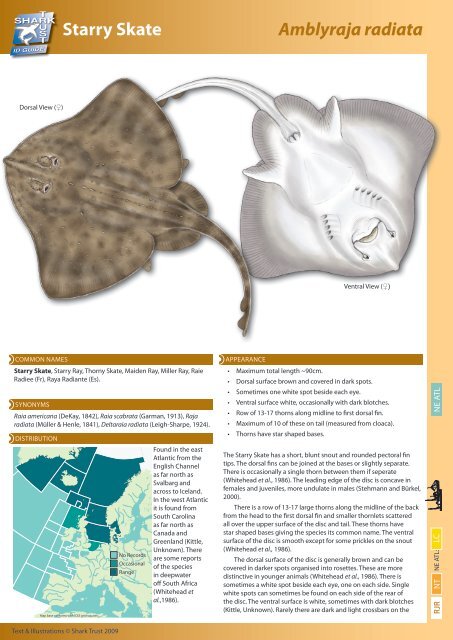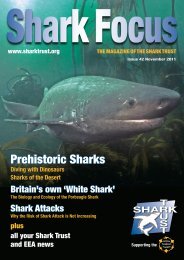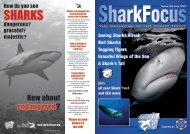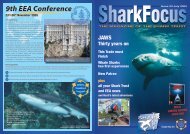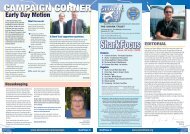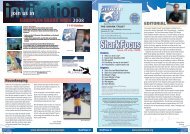Starry Skate Amblyraja radiata - The Shark Trust
Starry Skate Amblyraja radiata - The Shark Trust
Starry Skate Amblyraja radiata - The Shark Trust
Create successful ePaper yourself
Turn your PDF publications into a flip-book with our unique Google optimized e-Paper software.
Dorsal View (♀)<br />
COMMON NAMES<br />
<strong>Starry</strong> <strong>Skate</strong> <strong>Amblyraja</strong> <strong>radiata</strong><br />
<strong>Starry</strong> <strong>Skate</strong>, <strong>Starry</strong> Ray, Thorny <strong>Skate</strong>, Maiden Ray, Miller Ray, Raie<br />
Radiee (Fr), Raya Radiante (Es).<br />
SYNONYMS<br />
Raia americana (DeKay, 1842), Raia scabrata (Garman, 1913), Raja<br />
<strong>radiata</strong> (Müller & Henle, 1841), Deltaraia <strong>radiata</strong> (Leigh-Sharpe, 1924).<br />
DISTRIBUTION<br />
Map base conforms with ICES grid squares.<br />
Text & Illustrations © <strong>Shark</strong> <strong>Trust</strong> 2009<br />
No Records<br />
Occasional<br />
Range<br />
Found in the east<br />
Atlantic from the<br />
English Channel<br />
as far north as<br />
Svalbarg and<br />
across to Iceland.<br />
In the west Atlantic<br />
it is found from<br />
South Carolina<br />
as far north as<br />
Canada and<br />
Greenland (Kittle,<br />
Unknown). <strong>The</strong>re<br />
are some reports<br />
of the species<br />
in deepwater<br />
off South Africa<br />
(Whitehead et<br />
al.,1986).<br />
APPEARANCE<br />
• Maximum total length ~90cm.<br />
• Dorsal surface brown and covered in dark spots.<br />
• Sometimes one white spot beside each eye.<br />
• Ventral surface white, occasionally with dark blotches.<br />
• Row of 13-17 thorns along midline to first dorsal fin.<br />
• Maximum of 10 of these on tail (measured from cloaca).<br />
• Thorns have star shaped bases.<br />
Ventral View (♀)<br />
<strong>The</strong> <strong>Starry</strong> <strong>Skate</strong> has a short, blunt snout and rounded pectoral fin<br />
tips. <strong>The</strong> dorsal fins can be joined at the bases or slightly separate.<br />
<strong>The</strong>re is occasionally a single thorn between them if seperate<br />
(Whitehead et al., 1986). <strong>The</strong> leading edge of the disc is concave in<br />
females and juveniles, more undulate in males (Stehmann and Bürkel,<br />
2000).<br />
<strong>The</strong>re is a row of 13-17 large thorns along the midline of the back<br />
from the head to the first dorsal fin and smaller thornlets scattered<br />
all over the upper surface of the disc and tail. <strong>The</strong>se thorns have<br />
star shaped bases giving the species its common name. <strong>The</strong> ventral<br />
surface of the disc is smooth except for some prickles on the snout<br />
(Whitehead et al., 1986).<br />
<strong>The</strong> dorsal surface of the disc is generally brown and can be<br />
covered in darker spots organised into rosettes. <strong>The</strong>se are more<br />
distinctive in younger animals (Whitehead et al., 1986). <strong>The</strong>re is<br />
sometimes a white spot beside each eye, one on each side. Single<br />
white spots can sometimes be found on each side of the rear of<br />
the disc. <strong>The</strong> ventral surface is white, sometimes with dark blotches<br />
(Kittle, Unknown). Rarely there are dark and light crossbars on the<br />
NE ATL<br />
NE ATL: LC<br />
NT<br />
RJR
SIMILAR SPECIES<br />
<strong>Starry</strong> <strong>Skate</strong><br />
tail, making confusion with the Thornback Ray, Raja clavata, possible (Stehmann and Bürkel, 2000).<strong>The</strong> <strong>Starry</strong> <strong>Skate</strong> can reach a maximum total<br />
length of 90cm in deep water and higher latitudes. This is reduced to around 60cm in shallower water and lower latitudes. In the latter case it<br />
matures at around 40cm but in the deeper, more northerly populations it may still be immature at 80cm (Whitehead et al., 1986). Mature males<br />
have extremely large claspers with thickened, club-like ends and a single, stiff spine on the upper lobe of each (Stehmann and Bürkel, 2000).<br />
<strong>Amblyraja</strong> hyperborea, Arctic <strong>Skate</strong><br />
Leucoraja fullonica, Shagreen Ray<br />
Raja asterias, <strong>Starry</strong> Ray (not illustrated)<br />
Raja clavata, Thornback Ray<br />
<strong>Amblyraja</strong> hyperborea,<br />
Arctic <strong>Skate</strong><br />
Raja clavata,<br />
Thornback Ray<br />
(Not to scale)<br />
Supported by:<br />
Text & Illustrations © <strong>Shark</strong> <strong>Trust</strong> 2009<br />
<strong>Amblyraja</strong> <strong>radiata</strong>,<br />
<strong>Starry</strong> <strong>Skate</strong><br />
Leucoraja fullonica,<br />
Shagreen Ray
TEETH<br />
<strong>Starry</strong> <strong>Skate</strong> <strong>Amblyraja</strong> <strong>radiata</strong><br />
<strong>The</strong> dentition consists of 36-46 rows of teeth<br />
with round bases on each jaw plate. Females<br />
and juveniles have low cusps which are worn<br />
almost smooth in the older rows. Mature<br />
males have sharper, more widely spaced<br />
teeth which are used to hold the female<br />
during copulation (Kittle, Unknown). <strong>The</strong>y<br />
may also be indicative of a difference in diet<br />
between the sexes, although this has not<br />
been observed (Packer et al., 2003).<br />
ECOLOGY & BIOLOGY<br />
HABITAT<br />
<strong>The</strong> <strong>Starry</strong> <strong>Skate</strong> is found in marine and brackish waters in depths<br />
ranging from 18 to 1,200m (60–3,940ft) and temperatures of -1.3-<br />
14°C (29.7–57.2°F), although it is predominantly encountered from<br />
50–100m (164–328ft) in temperatures of 2-5°C (35.6–41°F). It can<br />
tolerate salinity levels of 31.2-35.3 parts per thousand. A bottom<br />
dwelling species in coastal seas and on continental shelves, It is<br />
found over a variety of substrates such as sand, gravel and soft mud<br />
(Kittle, Unknown).<br />
DIET<br />
Studies from across the North Atlantic have shown that the <strong>Starry</strong><br />
<strong>Skate</strong> is an opportunistic feeder, feeding on the most abundant<br />
and available prey species in an area (Skjæraasen and Bergstad,<br />
2000). In the northwest Atlantic, polychaetes and decapods are<br />
the major prey items followed by amphipods and euphausiids.<br />
Fishes and mysids are present but constitute a small part of the<br />
diet (McEachran et al., 1976). It is apparently not uncommon for the<br />
<strong>Starry</strong> <strong>Skate</strong> to feed on trawler discards (Berestovskii, 1989).<br />
REPRODUCTION<br />
<strong>The</strong> <strong>Starry</strong> <strong>Skate</strong> is oviparous and, in the Gulf of Maine at least,<br />
reproductively active all year round (Kittle, Unknown). As with most<br />
elasmobranchs it matures relatively late. In North American and<br />
Canadian waters it reaches a maximum recorded age of 16 years<br />
and does not reach sexual maturity until 11 years of age at a length<br />
of 88cm for males and 86.5cm for females (Kittle, Unknown).<br />
<strong>The</strong> females lay up to 88 eggcases (usually with more in the<br />
right ovary than the left) per year (Whitehead et al., 1986) which<br />
are deposited on sand or mud substrates (Kittle, Unknown). <strong>The</strong>se<br />
eggcases measure 42-66mm long (excluding horns) and 25-53mm<br />
wide (Whitehead et al., 1986). Laboratory studies have shown<br />
the incubation period for these eggcases can be as long as 2-2.5<br />
years in water temperatures of -0.3-9.5°C. When the young finally<br />
emerge they are fully formed and measure 10.4–11.4cm in length<br />
(Berestovskii, 1994).<br />
It is thought that <strong>Starry</strong> <strong>Skate</strong> eggcases are eaten by a variety<br />
of fish such as Atlantic Halibut, Hippoglossus hippoglossus, and the<br />
Greenland <strong>Shark</strong>, Somniosus microcephalus (Kittle, Unknown).<br />
Text & Illustrations © <strong>Shark</strong> <strong>Trust</strong> 2009<br />
EGGCASE<br />
1. Small, 34-89mm in length (excluding horns).<br />
2. 23–68mm in width.<br />
3. Obvious keels (<strong>Shark</strong> <strong>Trust</strong>, 2008).<br />
Similar eggcase to the Thornback Ray, Raja clavata.
COMMERCIAL IMPORTANCE<br />
Historically, the <strong>Starry</strong> <strong>Skate</strong> has not been commercially important<br />
due to its small size. However, it is regularly taken and sold in<br />
multispecies trawls across its range. As populations of other species<br />
of skate decline it is likely that it will be targeted, a process that has<br />
already begun in the western Atlantic (Kittle, Unknown).<br />
THREATS, CONSERVATION, LEGISLATION<br />
<strong>The</strong> <strong>Starry</strong> <strong>Skate</strong> is the most abundant skate in the North Sea and<br />
it is possible that its population has increased to fill the niche left<br />
by falling populations of larger species such as the Common <strong>Skate</strong>,<br />
Dipturus batis and the Long-nosed <strong>Skate</strong>, Dipturus oxyrinchus. In<br />
the central North Sea, a marked increase in numbers was observed<br />
between 1970 and 1983 with similar increases being observed<br />
between 1982 and 1991 across English waters. A recent survey<br />
indicated a decline but this is believed to be a result of a change in<br />
survey gear (Gibson et al., 2006).<br />
It is common throughout the northeast Atlantic but is not so<br />
abundant in the northwest. <strong>The</strong> government of the USA has recently<br />
banned commercial targeting of the species in response to reports<br />
of falling populations along the coast of North America (Kittle,<br />
Unknown). In the Black Sea, it can regularly constitute as much as<br />
96% of the elasmobranchs caught in survey trawls or as bycatch<br />
(ICES, 2008b).<br />
All rajids are managed under a Total Allowable Catch (TAC)<br />
system in EU waters. Between 1999 and 2005 the 6,060t TAC was<br />
reduced by 47% and by a further ~50% from 2005 to 2008 (ICES,<br />
2008). Originally the TAC applied only to areas IIa and IV, however in<br />
January 2009 the TAC was extended to include ICES divisions IIa, IIIa,<br />
IV, VIa-b, VIIa-k, VII and IX.<br />
<strong>The</strong> table below gives a summary of the TAC’s for the years 2004 to<br />
2009.<br />
ICES<br />
Division<br />
2004 2005 2006 2007 2009 2009<br />
IIa, IV 3,503 3,220 2,737 2,190 1,643 1,643<br />
IIIa N/A N/A N/A N/A N/A 68<br />
VIa-b,<br />
VIIa-c,<br />
VIIe-k<br />
Supported by:<br />
N/A N/A N/A N/A N/A 15,748<br />
VIId N/A N/A N/A N/A N/A 1,044<br />
VIII, IX N/A N/A N/A N/A N/A 6,423<br />
(All figures in tons. European Union, 2009)<br />
Since 2008, European countries have been required to record<br />
most skate and ray landings by species to give a clearer picture of<br />
the status of populations in EU waters (ICES, 2008a).<br />
Some Sea Fisheries Committees (SFC) around the UK have<br />
byelaws which stipulate a minimum disc width (DW) for landed<br />
skates and rays, measured from the extreme tips of the pectoral fins.<br />
<strong>The</strong>se range from 36 to 45cm depending on the area (NFFO, 2004).<br />
Many recreational anglers return any sharks, skates and rays<br />
they catch alive and some angling clubs have begun tag and release<br />
programmes (Holt, 2005). However, such localised management<br />
strategies are unlikely to be significant for the conservation of wider<br />
populations (Fowler et al., 2005).<br />
Text & Illustrations © <strong>Shark</strong> <strong>Trust</strong> 2009<br />
IUCN RED LIST ASSESSMENT<br />
Vulnerable (2008).<br />
Least Concern in northeast Atlantic.<br />
HANDLING AND THORN ARRANGEMENT<br />
• Handle with care.<br />
• Row of strong thorns on midline.<br />
• Large thorns on shoulder and nape.<br />
<strong>Starry</strong> <strong>Skate</strong>
REFERENCES<br />
<strong>Starry</strong> <strong>Skate</strong> <strong>Amblyraja</strong> <strong>radiata</strong><br />
BERESTOVSKII, E. G. 1989. Feeding in the skates, Raja <strong>radiata</strong> and<br />
Raja fyllae, in the Barents and Norwegian Seas. J. Ichthyol. 29:<br />
88-96.<br />
BERESTOVSKII, E. G. 1994. Reproductive biology of skates of the<br />
family Rajidae in the seas of the far north. J. Ichthyol. 34: 26-37.<br />
EUROPEAN UNION. 2009. Council Regulation (EC) No. 43/2009.<br />
Official Journal of the European Union, L22/1.<br />
FOWLER, S. L., CAVANAGH, R. D., CAMHI, M., BURGESS, G. H.,<br />
CAILLIET, G. M., FORDHAM, S. V., SIMPFENDORFER, C. A.,<br />
MUSICK, J. A. 2005. <strong>Shark</strong>s, Rays and Chimaeras: <strong>The</strong> Status of<br />
the Chondrichthyan Fishes. IUCN SSC <strong>Shark</strong> Specialist Group.<br />
IUCN Publications. Cambridge, UK.<br />
GIBSON, C., VALENTI, S. V., FOWLER, S. L., FORDHAM, S. V., 2006. <strong>The</strong><br />
Conservation Status of Northeast Atlantic Chondrichthyans;<br />
Report of the IUCN <strong>Shark</strong> Specialist Group Northeast Atlantic<br />
Regional Red List Workshop. VIII + 76pp. IUCN SSC <strong>Shark</strong><br />
Specialist Group.<br />
HOLT, D. 2005. Common <strong>Skate</strong> tagging programme. <strong>The</strong> Scottish<br />
Angling Homepage. www.catchalot.co.uk.<br />
ICES. 2008a. Demersal elasmobranchs in the North Sea (Subarea<br />
IV), Skagerrak (Division IIIa), and eastern English Channel<br />
(Division VIId). ICES advice 2008, Book 6.<br />
ICES. 2008b. Report of the Working Group Elasmobranch Fishes.<br />
Copenhagen, Denmark.<br />
KITTLE, K. Unknown. Thorny <strong>Skate</strong>. Florida Museum of Natural<br />
History. www.flmnh.ufl.edu/fish/.<br />
MCEACHRAN, J. D., BOESCH, D. F., MUSICK, J. A. 1976. Food division<br />
within two sympatric species-pairs of skates (Pisces: Rajidae).<br />
Mar. Biol. 35: 301-317.<br />
NFFO. 2004. Official Yearbook and Diary. Grimsby, UK.<br />
PACKER, D. B., ZETLIN, C. A., VITALIANO, J. J. 2003. Thorny <strong>Skate</strong>,<br />
<strong>Amblyraja</strong> <strong>radiata</strong>, Life History and Habitat Characteristics.<br />
NOAA Technical Memorandum NMFS-NE-178.<br />
SHARK TRUST. 2008. Identify Your Eggcase. www.sharktrust.org.<br />
SKJÆRAASEN, J. E. BERGSTAD, O. A. 2000. Distribution and feeding<br />
ecology of Raja <strong>radiata</strong> in the North-eastern North Sea and<br />
Skagerrak (Norwegian Deep). ICES J. Mar. Sci. 57: 1249-1260.<br />
STEHMANN, M., BÜRKEL, L. 2000. Field key to Common <strong>Skate</strong><br />
Species (Raja spp.) in Northern EC Shelf Waters. Grafik Design<br />
Studio GmbH. Hamburg, Germany.<br />
WHITEHEAD, P. J. P., BAUCHOT, M. L., HUREAU, J. C., NIELSEN, J.,<br />
Text & Illustrations © <strong>Shark</strong> <strong>Trust</strong> 2009<br />
TORTONESE, E. (Eds.). 1986. Fishes of the Northeast Atlantic and<br />
Mediterranean. UNESCO. Paris, France.<br />
Text: Richard Hurst.<br />
Illustrations: Marc Dando.<br />
Citation<br />
<strong>Shark</strong> <strong>Trust</strong>; 2009. An Illustrated Compendium of <strong>Shark</strong>s, <strong>Skate</strong>s, Rays<br />
and Chimaera. Chapter 1: <strong>The</strong> British Isles. Part 1: <strong>Skate</strong>s and Rays.<br />
Any ammendments or corrections, please contact:<br />
<strong>The</strong> <strong>Shark</strong> <strong>Trust</strong><br />
4 Creykes Court, <strong>The</strong> Millfields<br />
Plymouth, Devon PL1 3JB<br />
Tel: 01752 672008/672020<br />
Email: enquiries@sharktrust.org<br />
For more ID materials visit www.sharktrust.org/ID.<br />
Registered Company No. 3396164.<br />
Registered Charity No. 1064185


